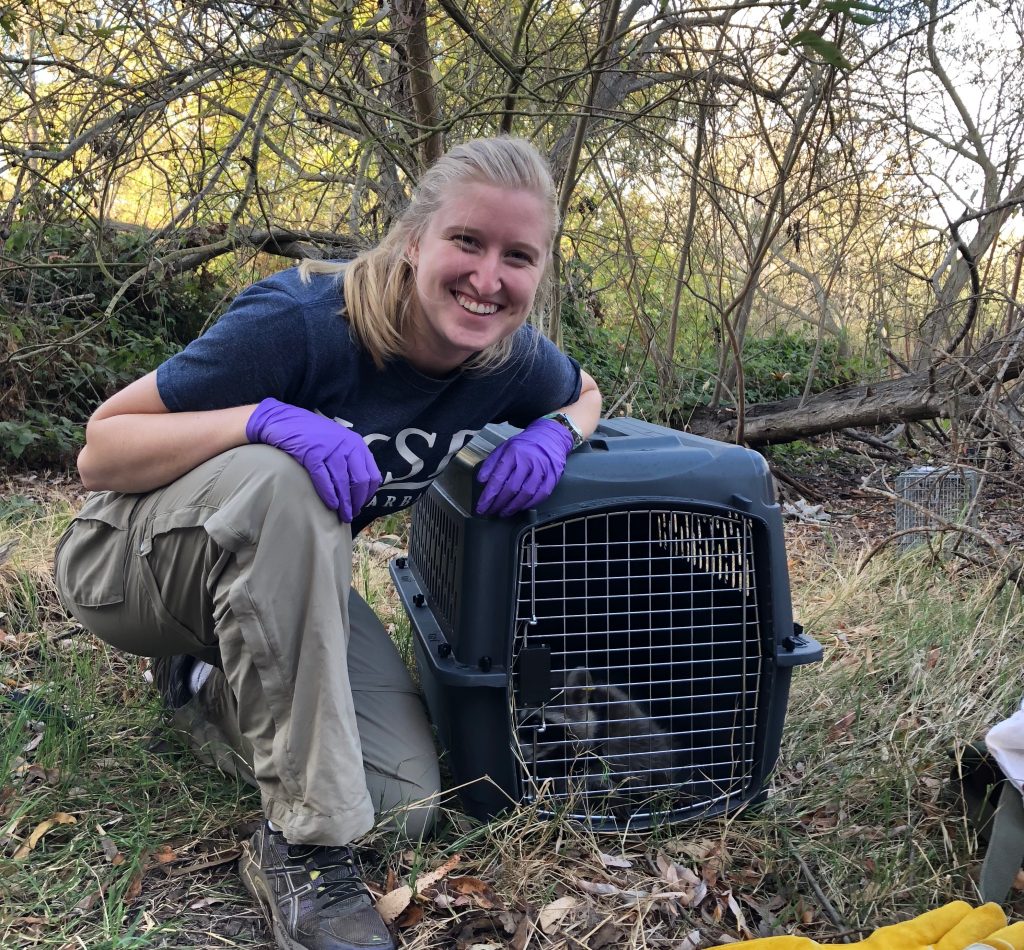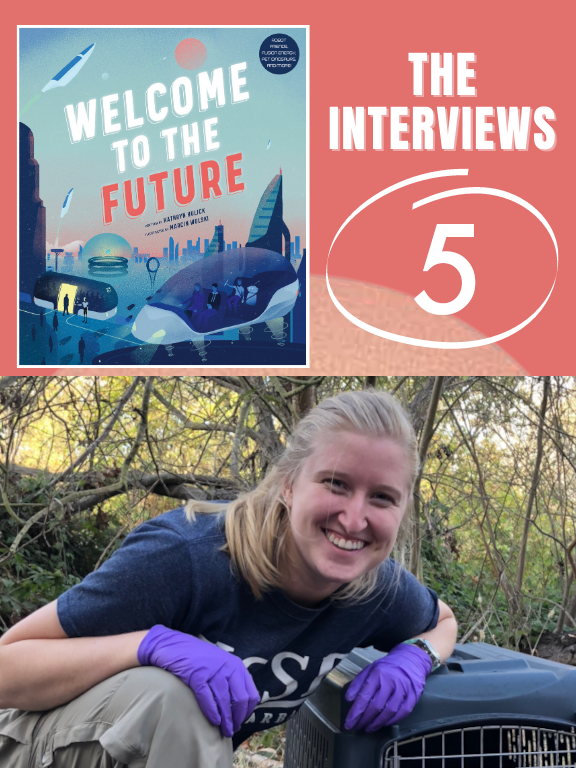In this series of interviews. I ask scientists, engineers, and ethicists how technology might change our future. We had these conversations during the research for my book, Welcome to the Future (Quarto, 2021).
Interview 5 – Molly Hardesty-Moore, ecologist
Molly Hardesty-Moore is a PhD candidate at the University of California, Santa Barbara. Though she mainly studies currently living species including raccoons, opossums, and skunks, she has also co-authored a paper about the ethics of de-extinction. That’s the science of bringing extinct creatures back to life. Some groups of scientists are already working on resurrecting the woolly mammoth. Bringing dinosaur-like animals to life might someday be possible as well. We spoke in October 2019.
In my book, I talk about the idea that we might someday bring back dinosaurs or even create animals that never actually existed. How does the idea of a future filled with creatures from the past or even from the human imagination make you feel?
Everyone’s going to have a different answer. For me as an ecologist, I start to feel nervous, because I think a lot about ecosystems and how things are connected. We have a lot of problems already with introducing new species into an area. They may become invasive. Having an idea of what a species may do — whether it existed in the past or never existed – before putting it out into the world would be so important. Ecosystems are really complicated and can be really hard to predict, even if you do studies beforehand.
What’s a specific thing you’d be worried about? Let’s say the Jurassic Park and Jurassic World movies become reality and someone releases a dinosaur into the wild?
With a dinosaur, my first question would be, “why?” This world we have now is not anything like the world they lived in 65-plus million years ago. So why are we putting them into nature? If you have it in a zoo or something, maybe that’s a different scenario. But why would you release an animal that has never lived in this world we have? We have no idea how it would interact. It would completely change ecosystems. To me, that would be very irresponsible and weird.
Let’s talk about the process of de-extinction. No one has brought any species back from extinction yet. Could this actually happen?
It’s definitely possible. I think it would not be the exact species that we originally had around, unless they were using cloning. That would make an exact copy of that animal — but only one. You usually want to bring back a whole population. If you look at Revive and Restore, they have a lot of these projects. They have a timeline of when they think they could actually have a passenger pigeon, for example. Their timeline was sometime in the next few decades. I think it could be a little bit longer. It’s complicated to actually birth a creature and have it then live after that. There are a lot of complications with genetic engineering. An extinct ibex was successfully cloned [in 2009] but died a few minutes after it was born. Having a viable population [of an extinct species], not just a few individuals in a zoo, but a population living out in nature – is going to be harder than people might think. If it happens at all, I’d expect it will take many decades.
What is holding us back when it comes to genetic engineering?
People are still learning about the genome, and what part of it does what. Changing this, what does that mean, and how is it tied to other parts of the genome. We still don’t really know at this point. We’re still learning. So until we have a better idea about how tweaking one thing might change other parts of the whole genome I think we’re still going to see a lot of complications.
The idea here is if you want to have a dinosaur-like chicken, giving it teeth might mess up some other part of its biology that you weren’t expecting?
Exactly. Some genes are linked to other genes. So when you change one part it can have an effect you didn’t even intend. The only reason I can see for doing that chicken to dinosaur experiment is just to learn more about the genes that are related — what makes the beak, what makes the teeth, that kind of thing.
What do you think is the most likely method that could bring back an animal that’s extinct?
With dinosaurs, we could make a sort of dinosaur-y chicken, maybe. But we don’t have genetic data from dinosaurs. That’s too far in the past for it to be preserved. For things like a mammoth or passenger pigeon, we have genetic information [from preserved cells and tissue]. So what they’re doing for those is genetic engineering.
For really recently extinct animals, like the aurochs [an extinct wild cow], they’re doing back breeding. That can take a really long time. That’s selectively taking individuals [from a closely related species] that seem to have the characteristics of the extinct species and breeding them together. So you need a big population of close relatives and years and years to start to get to something. I think genetic engineering is the favorite method in this field right now.
The idea there is you have a sample of the genes from the extinct species, and you can use that as a map to try to change the genes of a species that is closely related?
Exactly. They have most of the genome for these species, and they are trying to splice it in and change the genome of a related species. For the mammoth, it’s the asian elephant. For the passenger pigeon, it’s the band-tailed pigeon.
The idea would be you’d have an Asian elephant give birth to a mammoth, at some point?
Yes, that’s the idea. I think they are trying to figure out a way to do it in the lab because elephants are really hard to breed in captivity. They have really long gestation periods and a really long time between births and they are also endangered. So there are some animal welfare questions there. They don’t have a method in the lab to go through gestation. So right now it’s thought that the Asian elephant would birth a baby mammoth.
Even if it’s possible to bring back these animals, it doesn’t mean it’s a good idea. What are some of the main ethical concerns about de-extinction? Why might it not be a great idea?
One is animal welfare. Both the welfare of the related species, especially if it’s endangered like the Asian elephant, and the welfare of the species you’re trying to create. If it lives for a few minutes and then dies, there are some questions about the morals of doing something like that. It could be very traumatic for these animals.
Also, there are moral questions about de-extinction in general. Are we playing God? As an ecologist, I think a lot about the question: Why do we want to do this? It’s a cool thing, maybe, to create these species. But having something living in captivity in a zoo or Jurassic Park where people are just gawking at it — to make something just for the purpose of human entertainment — seems a little morally sketchy.
There are conservation reasons to do this, though. We could bring back some important species that will have really positive effects on ecosystems. That’s a big one for the mammoth. To have this positive effect you need to make sure that you have an idea of what would actually happen releasing the species back thousands of years after it went extinct. Also, could you have a viable population size that would have the effect you want? And would the threats be gone that originally caused the extinction? If that threat is humans hunting them or whatever, do we have regulations in place to keep them safe? I think conservationists have concerns over how much resources would go into something like this versus how much benefit you would gain. The resources could be put into something a little more realistic. You can use genetic engineering to try to save a population that still exists, for example. I think those are some of the big [ethical] questions.
Instead of bringing back the mammoth, you could use your genetic engineering power to help a species on the brink of extinction, such as the black rhinoceros. You could maybe make it easier for them to reproduce or find a cure for some disease that’s killing a lot of them?
Exactly. Pursuing this cool, interesting path can lead people onto more realistic and helpful paths. For the mammoth – I personally think it’s not a good idea to bring back a hairy Asian elephant and release it into Siberia. But through that project they learned about this virus that’s affecting Asian elephant populations today that has some relation to their genetic code. And they’re now trying to synthesize a cure for this virus. They stumbled upon this by looking into de-extincting the mammoth.
You mentioned that bringing a species back might help ecosystems. In what way might de-extinction have a positive impact?
There are some species in ecosystems that have really strong interactions. Some living examples are sea otters or wolves. Mammoths are really large animals, like elephants, that have really large impacts on their ecosystem. When you remove something like that – you have a lot of changes that have been seen as negative. If you take sea otters out of a kelp forest, you get all sea urchins and no more kelp. Mammoths are believed to have helped maintain this tundra steppe ecosystem they lived in by trampling snow, dispersing nutrients because they moved long distances, and breaking down woody plant material. Without these large herbivores the ecosystem changed dramatically.
People have tried putting back some species in these areas to see what it would be like. Pleistocene Park is a thing in Russia. They put horses and other ungulates in the tundra to see how the ecosystem would change. It seems to have pretty major effects. So they think if we put back the mammoth, then we’d have the whole ecosystem again. The idea would be that reintroducing these species that are now extinct could help maintain ecosystems that have fallen into disrepair since their extinction.
But there’s also this problem that ecosystems can cross a threshold where they can’t come back, or it’s really hard to make them come back. You have to make sure you haven’t crossed this threshold. Putting a species back may not have an effect because it’s too late. The idea would be to bring back an important function the animal once had.
Is there an extinct animal for which you think there still is an important function in an ecosystem?
We wrote a paper where we talk all about functional ecology and how it relates to de-extinction. At the end we tried to think of some species that might be worth bringing back. They’re all not the most exciting species. But we have a few examples. The Christmas island pipistrelle bat lived on Christmas Island. It was a unique species that only existed on this island and it went extinct recently in 2009. Bats can have important ecosystem effects. For example, they control insect populations. These islands have introduced insects like mosquitoes, and this species could help control pests as well as keep insect populations down in general.
What about the idea of creating completely new animals or plants through genetic engineering? I’ve read about people who have imagined giving a Komodo dragon wings to make it look like a mythical dragon or giving a horse a horn to create a unicorn. Kids will find this absolutely amazing. How do you explain that it’s maybe not the best idea to make things just because we think it’s cool?
Yeah, I think that’s a great question. Sometimes doing things because they’re cool you can learn a lot. But there’s still a question of why. Giving a Komodo dragon wings, there’s a question of how you would do that. With a vertebrate body plan you should only have four limbs. So unless you’re turning the arms into wings, I can’t imagine how it would work.
Whatever you’re doing, though, you’re putting these animals through a lot. I think kids care about animal welfare. They don’t want to be hurting animals. They don’t want animals to be in pain. And all of these things we’re imagining doing cause some suffering. If there’s an end goal it may justifiable. But if you’re just putting horns or wings on an animal because it’s cool, that doesn’t really seem like enough of a justifiable reason for the suffering. To me, there would need to be more.
Any last words?
De-extinction is an exciting idea. If it is done with a lot of thought and protections of the animals and ecosystems, then it could be something that could have benefits.
That reminds me, I’ve read one more argument for de-extinction: if humans are the ones that screwed up and caused an extinction, do we have a responsibility to bring that species back?
I think that’s valid, although people might also say, don’t we have a moral responsibility to the creatures that are on the brink right now? That we still could save before they are gone, to maybe focus more on them?


